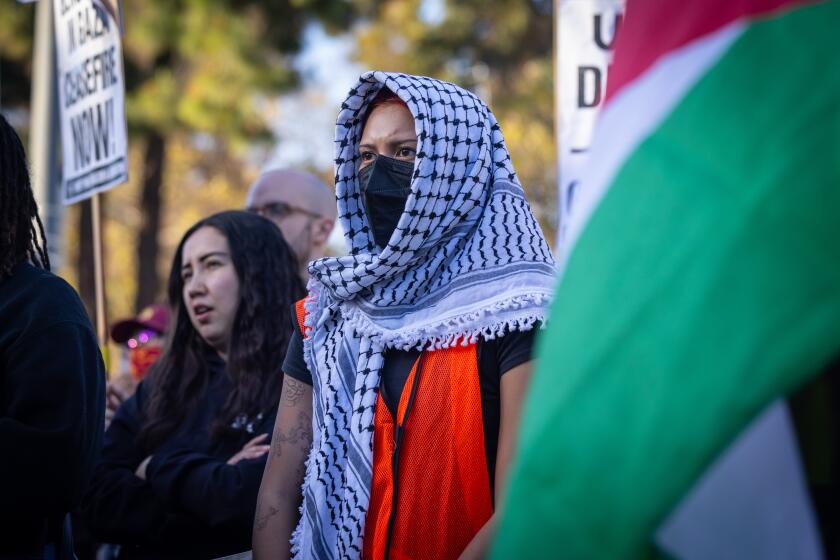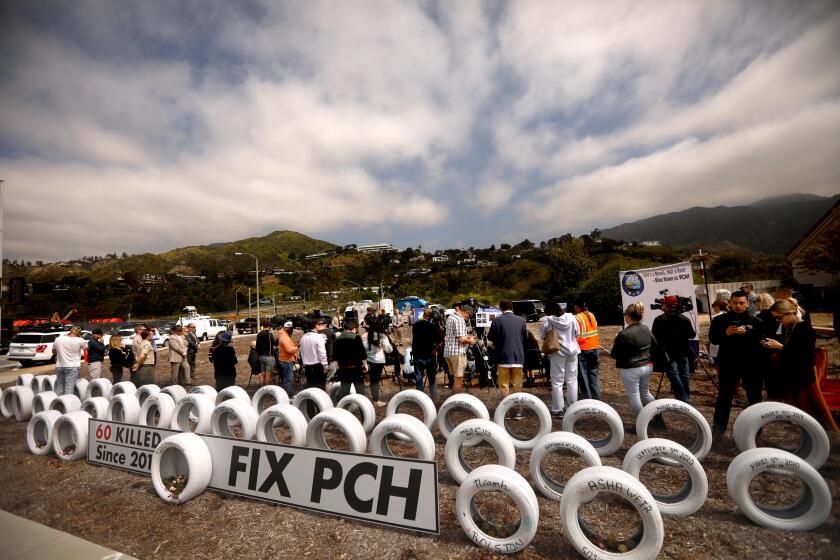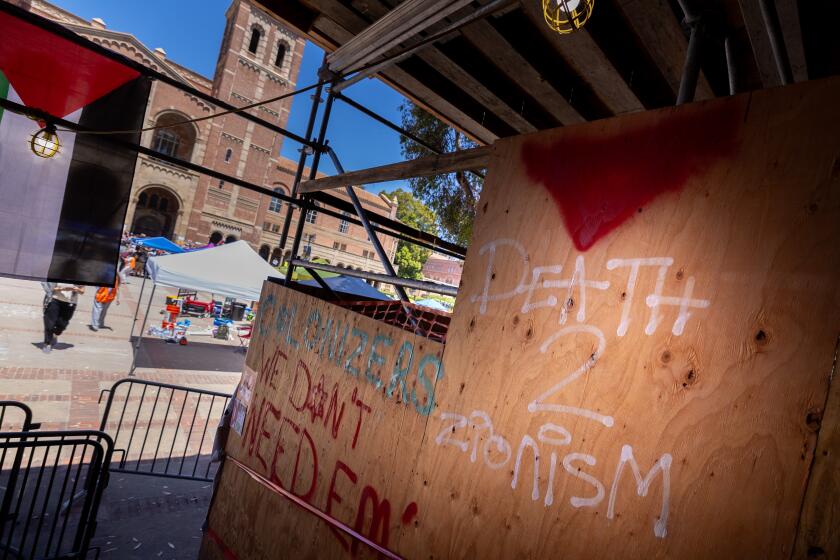L.A. Spraying of Malathion Is Postponed
Malathion spraying for Mediterranean fruit flies over a large sector of downtown Los Angeles was postponed Thursday as city and state officials clashed over the pesticide’s safety.
There was confusion throughout the day about whether the malathion-bearing helicopters would lift off on their scheduled Thursday night mission, which would have required finding protection for transients who would have been exposed to the pesticide.
It began Thursday morning when City Councilman Joel Wachs called a press conference to announce that the flights had been scratched because city lawyers had developed “substantive data” raising questions about the pesticide’s safety.
While Wachs would not elaborate, other city officials later explained that a test of the batch of malathion to be applied over downtown and surrounding neighborhoods contained unacceptable levels of heavy metals.
Throughout most of the afternoon, officials with the Medfly eradication project said they could not confirm that the flights indeed were canceled. This surprised and alarmed homeless advocates, who had been told to halt their preparations to open shelters in advance of the spraying over 14 square miles, including Skid Row.
Later in the afternoon, hours before the helicopters were to take off, state officials finally confirmed that the mission had been called off--at least until Monday--but they disputed Wach’s explanation. They said the postponement resulted from procedural delays created by the July 4 holiday.
The postponement marked the first time the state has canceled a scheduled spraying, except for bad weather.
“I think it’s fair to say that this is a major victory for the people of Los Angeles and the people of the state of California,” Wachs said. “It is the first time the state has finally agreed to stop the spraying until we can sit down at the table and really analyze the data and the evidence that is before us.”
Deputy Atty. Gen. Charles Getz, who has been handling the state’s litigation related to the Medfly eradication program, denied Wach’s version of events. Getz said he was unaware of any new evidence about malathion safety and said of the city officials: “They’ve obviously come out to put the best face on the stoppage.”
Getz said the postponement was arranged because routine test results on impurities in the malathion mixture could not be conducted because of the holiday. The tests are performed on every batch of malathion used in the spraying, he said.
Getz said the state also agreed to the delay as a “good faith” gesture in preparation for a negotiation session with city lawyers today.
The city and an environmental organization sued the state in February, contending that it was unsafe to apply malathion over residential neighborhoods. A trial is pending.
Wachs said the new data was developed in connection with the legal case.
Getz said the earliest that spraying could resume would be Monday.
Thursday night’s scheduled spraying was to have been the first in Los Angeles County after a three-week lull. Agriculture officials had announced that the spraying was to resume in Los Angeles in response to the discovery of a single Mediterranean fruit fly about a mile from where an infestation was first detected last summer.
The new round of malathion spraying was to have covered Echo Park, Elysian Park, downtown Los Angeles, Westlake, Silver Lake and other nearby neighborhoods. Although Dodger Stadium was in the spray zone, state officials exempted the ballpark, saying it contained no fruit trees.
According to John Emerson, the chief deputy city attorney handling the city’s suit against the state, an independent laboratory examination of malathion bait mix used by the state found “the presence of certain heavy metal contaminants” that exceed acceptable levels outlined in Proposition 65, a 1986 state initiative designed to protect people against exposure to chemicals.
The sample was obtained from the state three weeks ago as part of discovery in the city’s lawsuit. City officials said the bait mix contained excessive concentrations of nickel, lead and chromium, which are toxic to humans.
Proposition 65 prohibits businesses that employ 10 or more people from exposing members of the public to dangerous chemicals that cause cancer or birth defects, unless they provide a “clear and reasonable” warning of the danger.
The law, however, made government agencies exempt from all provisions, which means it does not apply to the Medfly operation.
City officials nonetheless believe that the state might not want to place itself in the uncomfortable position of exceeding its own requirements.
“Clearly,” one city source said, “the state doesn’t have any interest in spraying people with contaminants that are in excess of statutory risk levels.”
According to Emerson, the city presented its data to the state at noon Thursday. He described the findings as “preliminary,” and said they will be reviewed when the city and state officials meet today.
State officials were surprised by the claim that test results had turned up excessive quantities of impurities.
James Stratton, medical epidemiologist with the state Department of Health Services, said that the malathion used in the Medfly campaign has been tested at least three times for identical impurities.
“We have found traces of heavy metals in the malathion,” Stratton said, “but they are not much different than what is found in the crust of the earth. I thought this was a dead issue.”
Stratton said the state has begun testing a malathion sample that was taken at the same time as the city’s sample. He said the results should be available today, and he doubted they would show anything different from previous state tests.
“I would really be surprised,” Stratton said.
The postponement was cheered by many opponents of the spraying program as a sign that the state might be willing to reconsider its eradication strategy.
“What is important to us,” Emerson said, “is that they are postponing the spraying and that they are meeting with us (today) for some serious negotiations and discussions about how they are going to handle this from here on out. Whether or why or how that has taken place is really irrelevant.”
“We are just very, very delighted,” said Adelaide Nimitz, president of the community group Families Opposed to Chemical Urban Spraying. “We knew it was just a matter of time before the state would have to listen to the people.”
The postponement order ultimately had to be approved by state Department of Food and Agriculture Director Henry J. Voss.
Voss spent most of Thursday on business in the Central Valley, and as chaos enveloped the scheduled Thursday night spraying, his aides were unable to track him down for a decision. He called from Lodi after 3 p.m. and, after he was briefed, approved the postponement.
Karen Patterson, who is in charge of coordinating the city’s homeless programs, had spent the past few days preparing to move transients out of downtown Los Angeles to safe shelter.
She said the shelter system was ready Thursday morning when she heard from city attorneys that the spraying would be canceled. Thursday afternoon, she was told the spraying might not be delayed after all.
“We had the system all up and took it down and now what?” she said. “It’s been a rat race today.”
In San Bernardino County, agriculture officials had received notice from the eradication project that, along with Los Angeles, spraying would not take place over the city of San Bernardino Thursday night.
The postponment was later retracted, then reinstated.
“It’s made for a tough day,” said a county official. “Frustrating is a good word for it.”
Even the public relations staff of the eradication project appeared frustrated by the daylong uncertainty.
“It’s a total mess,” said spokeswoman Gera Curry.
More to Read
Start your day right
Sign up for Essential California for news, features and recommendations from the L.A. Times and beyond in your inbox six days a week.
You may occasionally receive promotional content from the Los Angeles Times.







